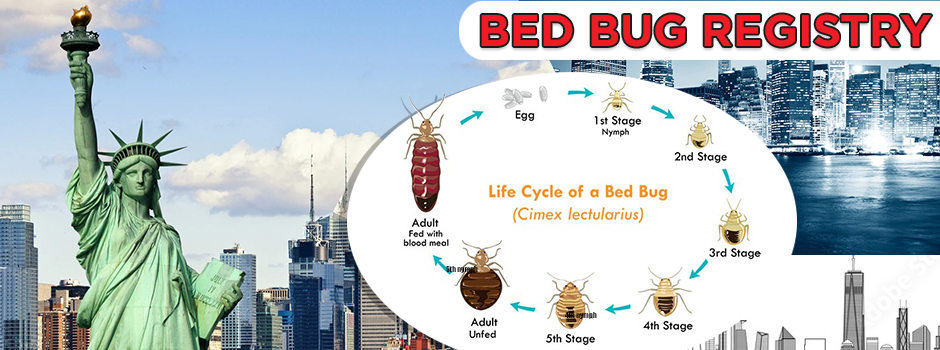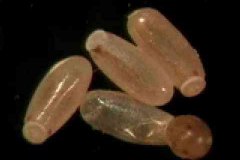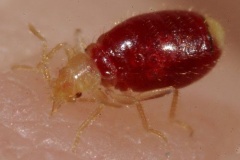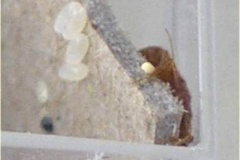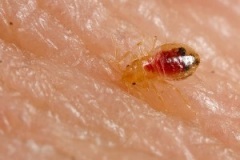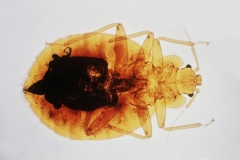Alvaro Romero is a doctoral student at the University of Kentucky. His most recent paper is in the January issue of the Journal of Medical Entomology.
We have long read about his research with avidity and the hope that we might have a chance to talk to him about bed bugs, resistance and other difficult bed bug topics.
Alvaro Romero very generously answered our questions via email.
New York vs Bed Bugs: Lets start with a shamelessly frivolous question, just because no one would ask you this except us. How are bed bugs fed at the lab?
Alvaro Romero: We feed our bed bug colonies with an artificial membrane feeder; this means there are no human subjects involved in this activity. We feed the bugs weekly on warmed animal blood supplied by a research supply company. Colonies remain in environmental chambers at constant temperature and humidity conditions and they are subjected to a specific light-dark cycle. This system allows us to rear, in the lab, several colonies collected from different areas across the country. Several graduate students working in our lab at the University of Kentucky are currently conducting experiments with bed bugs.
New York vs Bed Bugs: How do pyrethroids affect bed bugs?That is to say, how are they supposed to work?
Alvaro Romero: Pyrethroids negatively affect the nervous system of insects. In insects susceptible to pyrethroids, nerve transmission is disrupted. This toxicity in bed bugs is expressed with intense hyperactivity, incoordination, paralysis and/or death.
New York vs Bed Bugs: What happens when pyrethroid insecticides dont kill bed bugs? And what are the likely or known mechanisms of resistance? Are bed bugs detoxifying insecticides, becoming insensitive to them, avoiding them, or what are the possibilities?
Alvaro Romero: Insects and various other arthropods have the potential to reduce the toxic effect of pyrethroids by becoming insensitive to them (mechanism known as target site insensitivity), by limiting penetration of the insecticide through their cuticle (skin), or by breaking down the insecticides with enzymes before the chemicals reach their target. Some of these resistance mechanisms have already been recognized in bed bugs.
Since our 2007 report in the Journal of Medical Entomology which sounded the alarm about seemingly widespread pyrethroid resistance in bed bug populations in the United States, we have been looking into which resistance mechanisms are involved. Suffice it to say that we are finding evidence that some bed bug populations have a very efficient enzymatic arsenal to detoxify pyrethroids. We further suspect that other resistance mechanisms are responsible for pyrethroid resistance in these particular strains.
On the other hand, in a recent paper, Yoon et al. (2008) examined the resistance profile of bed bugs collected from New York City (NY-BB). They identified two point mutations in one of the genes that codes for pyrethroid-sensitive neural structures. Bed bugs having such mutations would remain unaffected by pyrethroids; or, in other words, they are insensitive to them. So I think there is already compelling evidence that bed bugs have the ability to develop resistance to pyrethroids.
New York vs Bed Bugs: The simplest indication of resistance we found is predicated on observation, that is, the failure to control a pest with customary materials. But by the time management failures occur, is insecticide resistance not already well-established?
Alvaro Romero: It is important to point out that there are factors other than insecticide resistance that may make an insecticide treatment ineffective, including 1) inability to have complete treatment coverage (e.g. excessive clutter, which makes hiding places difficult to reach, so some insects are not exposed to the insecticide), 2) reintroduction of bed bugs to the premises, and 3) tendency of bed bugs to avoid treated surfaces. Thus, treatment failure is not always synonymous with insecticide resistance. It is difficult to pinpoint when resistance begins. However, pest managers might suspect resistance when bugs persist in areas that they know were thoroughly and previously treated with insecticide.
New York vs Bed Bugs: Are there test kits for resistance available?
Alvaro Romero: There is a commercial kit (PDF) available to confirm resistance in bed bugs and other pests. Currently, however, no such kits are being marketed to the industry here in the United States.
New York vs Bed Bugs: How is insecticide resistance in bed bugs managed?
Alvaro Romero: Synergists are a good option to try to eliminate pyrethroid-resistant bed bugs. We know that the synergist, PBO, increases the toxicity of deltamethrin in some resistant strains. However, there are other resistant strains unaffected by such mixtures, and these are those which might be insensitive to pyrethroids, as I mention earlier. There are other synergists that have the potential to be used, but there is little research done so far on that issue. The other alternative is to include non-pyrethroid insecticides such as chlorfenapyr which is effective against resistant populations although its killing action is quite slow.
Given the fact that insecticide resistance is a threat and today there are not very many alternative insecticides, a sound recommendation is to incorporate chemical (residual and contact killer insecticides) and non-chemical methods in management programs, including vacuuming, heat treatment, and bed encasement, among others.
New York vs Bed Bugs: What is the suspected role of DDT or other pesticides long used against bed bugs in relation to the current occurrence of pyrethroid resistance?
Alvaro Romero: We know that there is cross resistance between DDT and pyrethroids in some of our lab populations. Whether this pyrethroid resistance seen today is related with DDT resistance reported since the 50s is unknown.
New York vs Bed Bugs: Tell us about the resistance studies you have conducted, what levels of resistance have you found, and to which insecticides?
Alvaro Romero: We have tested bed bugs, collected from different parts of the USA, with dry residue tests and have found a very high level of resistance to deltamethrin in most of the samples. Resistance was also very high in one strain we exposed to lambacyhalothrin, which suggests cross resistance between pyrethroids, as has been observed with other insects. All these samples were collected before the location was treated with insecticides. You can find more information on the JMEs article and the PCT article.
New York vs Bed Bugs: Youve also tested a non-pyrethroid currently in use against bed bugs, what have you found?
Alvaro Romero: We have tested chlorfenapyr, the active ingredient of Phantom, and although it is effective against all strains tested so far, its killing action is relatively slow. Bed bugs also generally need to rest on treated surfaces for longer periods of time compared to what is required with pyrethroid-type insecticides. The good thing is that bed bugs do not avoid chlorfenapyr-treated areas.
New York vs Bed Bugs: And is there any difference between technical grade (only the active ingredient) and formulated (the pesticide as sold) materials in your tests?
Alvaro Romero: The results between tests using technical grade and formulated material are generally similar. In the lab, in order to determine how susceptible or resistant a population is to a certain insecticide, and estimate accurately its resistance level, the active ingredient needs to be used. Similarly, when studying responses of bed bugs to insecticides it is crucial to determine whether the effect is caused by the active ingredient contained in the product or by some other component of the formulation (solvents, emulsifiers, etc).
New York vs Bed Bugs: Why dont bed bugs acquire a lethal dose of the insecticide?
Alvaro Romero: They do not acquire a lethal dose for several reasons, including: 1) they are resistant to the insecticide in use, 2) bugs do not encounter treated areas during their search for a host at nighttime, 3) bed bug hiding places are missed during application or, 4) they avoid walking or resting on treated areas.
New York vs Bed Bugs: What is the risk of repellency, behavioral avoidance and irritancy in bed bugs?
Alvaro Romero: Insects avoid prolonged exposures to insecticides by moving away from the treated area either due to repellency (after perceiving insecticides at some distance) or due to irritancy (after contacting the treated area). In our studies we were careful not to talk about repellency, because our bioassays were not designed to determine whether bed bugs were detecting insecticide treated areas at some distance. Our results showed that bed bugs tended to avoid resting on pyrethroid-treated surfaces (unless there were harborage odors).
As far as irritancy, video taped recordings of bed bugs interacting with pyrethroid-treated surfaces during the nighttime indicate that irritancy (expressed as locomotor hyperactivity) does occur. Irritancy increases the chance of insects moving across insecticide-treated surfaces which would accelerate the acquisition of lethal doses in susceptible populations.
You can find more information on these results in a recent article published in the JME.
New York vs Bed Bugs: What is the influence of fecal-marked harborages in the efficacy of insecticide treatments?
Alvaro Romero: In our studies, bed bugs did not avoid contact with insecticide deposits applied to established harborages containing feces and bed bug odors. This shows us how complex the interaction between bed bugs and insecticides can be. In our studies, harborages remained attractive to bed bugs after being treated with a pyrethroid. This indicates that attracting factors of harborages (pheromones) were unaltered after insecticide treatment. And this is good because the continued occupancy of bed bugs in such treated areas might increase exposure to the insecticide.
New York vs Bed Bugs: Can these behavioral effects increase the risk of bed bugs spreading from one apartment to an adjacent apartment?
Alvaro Romero: If bed bugs avoid insecticide treated areas, they can move to insecticide-free areas. This fact plus increased locomotor activity caused by pyrethroids might partly explain why places adjacent to infested areas become infested as well.
New York vs Bed Bugs: Is there a relationship between behavioral effects of avoidance or irritation and susceptibility?
Alvaro Romero: In our studies we found that pyrethroid-resistant bed bugs tended to avoid sitting on treated surfaces. We have limited information on the relationship between avoidance-prone vs. susceptible strains. Nevertheless, our results show that insecticide avoidance and physiological resistance can coexist. There is still a long way to go before determining, with accuracy, if this relationship is a generalization in bed bugs.
New York vs Bed Bugs: What is known about mating, egg laying, and, of course, feeding, after acquiring a sublethal dose of insecticide?
Alvaro Romero: We know very little about these sub-lethal insecticide effects on bed bugs. What we do know is that hungry bed bugs crawl over treated surfaces to reach a blood meal and this short exposure to the insecticide is not enough to kill and prevent them from feeding and subsequently reproducing.
New York vs Bed Bugs: We do know that pest management professionals can still control bed bugs with pyrethroids.What do you think is happening that, despite resistance, control can still occur in many cases?
Alvaro Romero: We have no doubt that there are bed bug populations that can still be controlled with pyrethroids. We have to consider, though, that in many cases an ongoing resistance problem can be masked because pest managers apply other products beside pyrethroid sprays to control infestations, including contact killers such as alcohol- or solvent-based insecticides. Thus, even if you are dealing with resistant bed bugs, you can still reduce numbers of bed bugs or luckily eliminate the infestation with a contact killerin the hypothetical case you could hit all individuals present. Fortunately, resistant bed bugs are not immune to the action of such contact killers. Bringing the number of bed bugs down quickly by using contact killers can give the impression that there is not a resistance issue. I am particularly worried, however, that despite multiple and thorough insecticide treatments, some bugs will persist, especially when there is an abundance of clutter. Those bugs are the ones that you could have missed with contact killers because they were not accessible at the moment of the treatment. Concealment is a critical issue in bed bug management, and that is why the use of an effective residual insecticide is desirable in control programs.
New York vs Bed Bugs: Can you tell us anything about additional projects you are working on? Obviously weve heard that you are working on circadian rhythms.
Alvaro Romero: I am currently conducting studies on bed bug ecology to determine how environmental cues as light and temperature affect locomotor activity of females, males and nymphs. Additionally, I am also investigating how feeding status affects the frequency of movement during nighttime. Our bed bug team at the University of Kentucky is working on many other projects also, which hopefully will provide relief to those who are suffering as a result of this most difficult pest.
Cited:
Follow this link:
An interview with bed bug researcher Alvaro Romero | New ...

 Residence
Residence  Location
Location 
